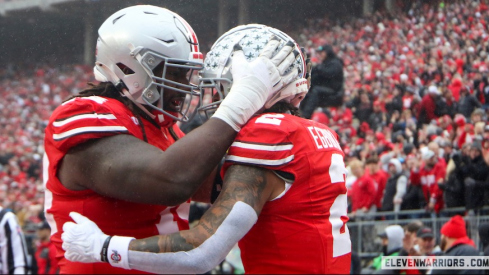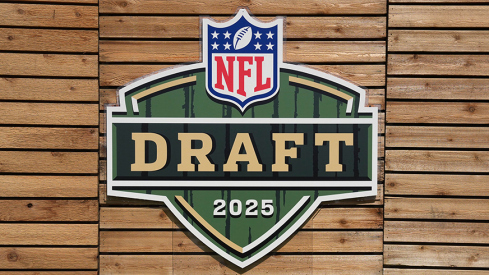
Ohio State put together perhaps its best all-around offensive performance of the Urban Meyer era against Iowa Saturday. The Buckeyes rolled up nearly 500 yards of offense, had a .862 drive efficiency and did not punt once.
The Buckeyes' offensive efficiency, not coincidentally, was led Braxton Miller's best overall game to date. With Miller healthy and effective in the passing game, the Ohio State offense demonstrated how difficult it can be to defend. A defense must account for Miller and Carlos Hyde behind a dominant offensive line, an efficient underneath passing game and the ability to hit deep routes.
Despite the effective performance, the Buckeyes only scored 34 points. One area where the Buckeye offense has sputtered in recent weeks is in the red zone. Just like at Northwestern, Ohio State settled for two red zone field goals against Iowa. The Buckeyes also turned the football over on downs. This is a step back from the previous year and a half under Meyer, and is preventing the Buckeyes from more quickly putting teams away. If the Buckeyes correct this recent blip their points total should quickly increase.
Below I examine how Ohio State attacked Iowa's cover 4 with an increasingly diversified run and pass offense, Miller's performance, and the Buckeyes' goal line difficulties against cover 0.
The Ole' Picking of the poison
Under defensive coordinator Norm Parker, Iowa has traditionally been a 4-3 over, cover-2 team. But the Hawkeyes largely abandoned cover 2 to employ tactics better calibrated to defend the Buckeyes' spread to run offenses. Instead, Iowa mixed quarter-quarter half with cover 4.

On third down, Iowa often played variations of man-under with linebacker delayed blitz support in the hopes of containing Miller.
The goal with the cover 4 variations is simple – have two safeties who are able to quickly come downhill to provide force support. The cover 4 safeties trigger upon the number two receiver to their side. If that receiver run blocks or sets up for a screen the safeties flow down against the run. This frees the interior six defenders to focus upon the Ohio State inside run game.
Fool Me Once...
Such a plan has previously been effective against Miller and Ohio State but failed for Iowa. And the reasons it failed demonstrates the increased versatility of the Buckeye offense.
As seen above, Cover 4's weakness is open space in the underneath flats and the Buckeyes exploited the Hawkeyes' vulnerable perimeter in the run and pass game.
As to the former, Ohio State's outside run game is becoming increasingly effective. For Meyer's tenure the Buckeyes have primarily been an inside run team while seeking to get Miller outside. But Ohio State has flipped this formula in recent weeks. Hyde's increased versatility – along with the contribution of Dontre Wilson – allowed the Buckeyes to get their backs outside an Iowa defense focused upon containing Miller. More specifically, the Hawkeye defense never had an answer for the Buckeyes' running backs on jet sweep action (titled bash under Ohio State's terminology) off read plays.
This was true on the Buckeyes' base inverted veer play (Mickey Bash in Meyer terminology, where Mickey stands for power blocking and Bash for jet sweep), but even more so on 13 Bash. Thirteen Bash is a tight zone play for the quarterback. The offensive line blocks inside zone and the quarterback reads the backside end. The running back, however, runs jet sweep away from the inside zone action. If the defensive end crashes, the quarterback gives on the jet sweep. If the defensive end stays, the quarterback keeps and runs straight up field. In other words, the play is an inside zone where the quarterback and tailback trade responsibilities.

Thirteen Bash is a counter to a team seeking to scrape exchange against base inside zone read (i.e. 13 Bible, where bible indicates read). Bash was open because, upon seeing the line blocking inside zone, Iowa's ends would slow play Miller, opening the outside for Hyde. Tight End Jeff Heuerman would seal the play side linebacker, providing Hyde an alley inside the wide receiver's stem block.

From there, Hyde generally did the rest.

Throw it Where they Ain't
While the run game is increasingly versatile, the Buckeye passing game has made even bigger strides. Like Northwestern, Iowa had its corners take deep drops in an attempt to prevent the Buckeyes from throwing the football down the field. This week, however, offensive coordinator Tom Herman did not force the issue. Instead, Ohio State took what was available and consistently completed curls, out routes, tight end flat routes, and flash screens all in the areas vacated by the Hawkeye corners. Outside receiver Devin Smith and Heuerman were the primary beneficiaries, having their best receiving games as Buckeyes.

The result was an efficient pass offense, as Iowa did not have a method to play the run, prevent the deep pass and not give up short and medium range throws. Ohio State was particularly effective throwing on first down. Unofficially, Ohio State attempted to throw approximately 18 times on first down, resulting in 14 completions as well as a Miller first down scramble. This kept the Buckeyes ahead of schedule and in numerous second and short situations.
Ohio State also exploited Iowa's cover 4 scheme for Miller's 58 yard touchdown to Philly Brown with play action off inverted veer. The benefit to this play fake is that it looks exactly like mickey bash, presenting the defense with the same blocking scheme. Below, Iowa's play side safety bit on the run fake, opening a large void for Brown's post route.


At the opposite end of the spectrum, the Buckeyes' wide receiver screen game was certainly the best its been since Meyer and Tom Herman's arrival. Smith was particularly effective here as well, as he was able to use his speed to get outside the stem block.
Ring leader
The key to making this diverse offense function was Miller. With a healthier knee and several games under his belt, Miller exhibited the improvements that many expected this season. His arm was as strong as ever, allowing him to throw outs and curl from one hash to the opposite side of the field before Iowa's corners could react. But he was also accurate, completing over 80% of his passes.
As, if not more importantly, Miller's improved pocket presence is making him a growing threat as a scrambler. As discussed, for as good as Miller is as a runner, he was a poor scrambler last year. He would often sit in the pocket without a good feel for when to run. He has vastly improved in that attribute, making several critical third and long scrambles to pick up first downs (in addition to a fourth down run that was called back for holding). His ability to do so will greatly diminish the ability of defenses to use man coverage on third down.

Miller is also more aggressively running north and south, showing less effects from the knee. If anything, he is now missing potential big plays by not bouncing outside.
As is shown by the effectiveness of the Buckeye outside running game, teams will continue to focus their efforts upon containing Miller. The test for Miller is now consistently playing at this level.
Red Zone Deficiency
Despite this multi-faceted attack, the Buckeyes still faced difficulties in the red zone, kicking two field goals. The question is whether this is schematic or a blip. Like Northwestern, Iowa went to a cover 0 look with no deep safety help at the goal line, which has caused Ohio State issues in recent weeks.
The Buckeyes in some ways effectively dealt with this coverage. For instance, the Buckeyes threw a tunnel screen to Devin Smith, blocking back against the man defenders.

With the first field goal, Braxton Miller was throwing to an open Evan Spencer on a double slant route in the end zone, and would likely have been a touchdown but for a defensive line deflection. Without that batted ball perhaps the Buckeyes' red zone offense is a non-issue.
Nonetheless, Ohio State can expect defenses to continue to use this aggressive defensive strategy. The Buckeyes must be prepared to run man coverage beaters at the goal line. The Buckeyes should perhaps also treat certain third and mediums as four down situations, allowing Ohio State to run on third down to set up fourth and short.
Miller's improved running ability should also help address this issue. As noted, a team should not be able to play man coverage and account for Miller. For instance, on the third down before the Buckeyes' last field goal, if Miller immediately cut back to the other side of the field he would have likely scored. Look for OSU to increasingly rely on him to run in such situations.
Meyer's Ohio State offense has generally been very good in the red zone, so perhaps this issue will be quickly resolved. If it is, look for the Buckeye point total to quickly jump because of how efficiently the offense is playing.
The Buckeyes' success begins up front. One facet that Ohio State can always count on is the ability to grind out yards with Hyde and its offensive line. Meyer and Herman can now combine this with the run threat of Miller, as well as exploiting the horizontal throws offered by defenses focused upon the run game and deep passing game. So long as the Buckeyes continue to efficiently throw the football, defenses will have a difficult time defending all aspects of Ohio State's offense.

